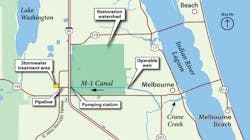Florida county to submit 17 resiliency projects to FDEP
In the 2021 legislative session, Gov. Ron DeSantis signed Senate Bill 1954 into law to address statewide flooding and sea level rise. At its monthly meeting on Tuesday, the St. Johns River Water Management District learned about 17 potential projects to support the Governor’s flood protection and resilience efforts.
The district plans to submit multiple projects to the Florida Department of Environmental Protection (FDEP) for inclusion in FDEP’s Statewide Flooding and Sea Level Rise Resilience Plan. Any approved projects will receive support to mitigate the risks of flooding or sea level rise on water supplies or water resources.
One project is the $10.6 million Crane Creek M-1 Canal Flow Restoration Project, a partnership between the District, FDEP and Brevard County to reduce nutrient loading and freshwater sediment flowing to the Indian River Lagoon. The project will restore approximately 7 million gallons of flow per day from a 5,300-acre watershed, currently discharging to the Indian River Lagoon, back to the St. Johns River following treatment in a stormwater treatment area. The project also increases freshwater flows to Lake Washington, the drinking water supply source for the city of Melbourne and other coastal communities. Water quality benefits include an estimated load reduction of 24,000 pounds of total nitrogen and 3,000 pounds of total phosphorus.
The District has proposed other projects for inclusion in the statewide flooding and sea-level rise resilience plan, including:
- Sebastian River Storage and Treatment nutrient load reduction and alternative water supply source
- C-10 Water Management Area freshwater flow reduction project and reservoir
- Raising levees at Sunnyhill to provide flood storage to the Upper Ocklawaha River
- Raising levees on the Lake Apopka North Shore for water storage and flood mitigation
- Adding flow capacity through S96C to provide increased discharge capacity from Blue Cypress Lake during storm events
- Adding flow capacity through S96D to provide increased discharge capacity from Blue Cypress Water Management Area during storm events
- Land acquisition at Bayard Point in the fiscal year (FY) 2021-2022 tentative budget, as well as the potential acquisition of other future critical land, floodplain and wetland priorities
- Nature-based green infrastructure in the FY 2021-2022 tentative budget includes restoration of the South Oslo Riverfront Conservation Area, Titusville Causeway seagrass planting and shoreline stabilization and the Riverside Conservancy Partnership Living Shoreline Restoration Initiative
- Future nature-based green infrastructure includes Sebastian Inlet wave attenuation seagrass planting, Satellite Beach seagrass restoration project, Merritt Island living shoreline installation, Tomoka Impoundment Area Restoration and Brevard Zoo Turkey Creek oyster reef addition.
The district supports state, regional, and local resiliency initiatives by providing technical assistance to communities, land acquisition and preservation, restoration of wetlands and floodplains for floodwater storage, water quality monitoring and habitat mapping programs.


